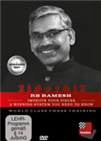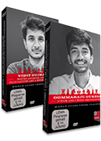The recipe for good moves
Sometimes chess is very complex — sometimes it’s simple.
Chess is like mobile phones: we only use one per cent of the possibilities!
But we can learn to master more — I teach the basics!
- Ramachandran Ramesh
Do you immediately choose the first dish in a restaurant that seems delicious to you? Probably not! You are probably one of those diners who look for several good options, then shortlist a few, and finally decide on the one you like best that day.
What does the new training course “Improve your pieces: A winning system you need to know” have to do with eating out? Well, in one of his many examples from everyday life, Indian star trainer RB Ramesh compares choosing a restaurant meal with choosing a move in chess: in chess, several alternatives should always be examined and the advantages of other variations should also be included in the analysis.
The Pep Guardiola of chess
In an interview from March 2023, ChessBase’s Arne Kaehler put the Indian grandmaster on a par with Pep Guardiola. This elicited a sympathetic and modest smile from Ramachandran Ramesh, as the chess coach born in 1976 in the Indian chess metropolis of Chennai.
But what may seem exaggerated to some at first can be substantiated: Ramesh has worked with many top Indian players, and thus played a decisive role in making India one of the leading chess nations. Gone are the days of Viswanathan Anand at the top and a huge gap between him and the next top players.
Ramesh also trains hundreds of chess students around the world, as Thorsten Cmiel reported back in 2019. The list of titles won by his protégés at (youth) world and Asian championships is beyond the scope of this article. RB Ramesh is currently working as a head coach in Norway, among other things, in order to broaden and improve chess there. In addition, he systematically works with 15 Romanian children at a training camp every two months.
A successful training method for ChessBase users
If you’re now thinking, “What does it have to do with me? I’ll probably never get to enjoy a Ramesh training session”. Far from it! With his FritzTrainer, Ramesh provides in-depth insights into his methodology. Ramesh has compiled instructive examples from players of different generations and summarises the motivation of the masters: “All players want to place pieces correctly and mix different concepts to do so”.
Ramesh takes you on a journey into the most important concepts of chess and explains them on the basis of his successful method. This is based on the identification of good, i.e. active, and bad, i.e. passive, pieces. In the introduction, Ramesh explains why he considers this to be the central challenge for improving one’s game. He offers 14 detailed lessons, each of which has a close look at an exemplary game and examines in detail the strengths and potential improvements of the pieces, considering the established pawn structure.
Pawns restrict pieces
 In this course, we will learn how to identify passively placed pieces in any given situation and how to improve their health by bringing them into active squares.
In this course, we will learn how to identify passively placed pieces in any given situation and how to improve their health by bringing them into active squares.
In a first example, Ramesh explains his way of thinking: the pawn just moved from d7 to d6 and turned active white pieces into much more passive ones, as it now covers its colleague on e5 from d6, which was previously only protected by the pieces. White should identify his passive pieces and try to activate them, i.e. place them on better squares. To do this, it is important to assess whether there is enough time for a longer manoeuvre or whether the opponent could open up the position in the meantime in order to get counterplay before I have improved my piece.
“Let me try to confuse you!”
With a wink, Ramesh asks if he can confuse us. Well, what choice does the viewer have when the trainer asks in which order the pieces should be improved? It depends on the strength of the pieces and the extent of their passivity. You can find out how to assess this in the exemplary games he presents.
1. Renet v. Jussupow

Position after 24.Rad1
The Indian grandmaster approaches all positions as follows: “Before we look for a move, we have to understand and judge the position. Who is better? To understand this, we need an evaluation process. This leads to recognising what the position requires”.
Ramesh goes back in his mind to the restaurant kitchen: “Everything that is possible is on the menu, the chef has to make sure that the ingredients go together. So learn to handle the position correctly”.
The spectator learns to look at the pieces one by one and realises — this idea is somewhat abbreviated here — that Yussupow came to the conclusion that Black should tackle his passivity by improving the knight. The logical, if not exactly eye-catching, 24...Nh8 followed. The knight wants to drive away the strong rook on d6 from f7.
Ramesh shows how Yussupow subsequently prepares the right moment for his pawn breakthrough with 14 (!!) consecutive piece moves. This example is an instructive introduction to the concept of ‘dynamic v. static’, which, alongside activity and passivity, plays a key role in the following analyses.
More examples
Ramesh never tires of emphasising how important independent thinking is for the learning process and thus for improving one’s playing strength. In his opinion, the basic prerequisite for the learning process is enthusiasm. Because without this enthusiasm for learning, learners make it unnecessarily difficult for themselves.
Now we will present an overview of the games that are presented in the course.

When it comes to optimal preparation and precise manoeuvring, the name Karpov quickly comes to mind. Anyone who was surprised by Jussupow’s solution in the previous game might be downright confused by Karpov’s move in the game against Schauwecker. But Ramesh calmly and systematically explains how even amateurs can arrive at a solution through the right thought process and reassures:
Even experienced players develop pieces, but don’t know where to go or what to do with them. We need criteria, especially when we don’t have much experience.
To prove this point, Ramesh uses the example of Kasparov's impressively quick victory over Hübner to introduce his multi-stage process for positional judgement.

- king security (except in most endgames)
- compare piece activity
- material: equal
- other positional features such as pawn structure, good bishops/bad bishops, space advantage, square weaknesses etc.
The star coach demonstrates this process in the following example: “Improving good-looking pieces: Example 4 - Klimov v. Fominyh”, and also goes into this in greater depth in the games by Miton and Kindermann that employ these principles. The latter also introduces the principle of ‘multiple ideas’ in one move — i.e. you should always pursue several intentions with your moves in order to make it as difficult as possible for your opponent.
 Two Super Grandmasters from India explain the ins & outs of Attack, Tactics an Calculations in these two video courses.
Two Super Grandmasters from India explain the ins & outs of Attack, Tactics an Calculations in these two video courses.In game 7, between Short and Vaganian, Ramesh also emphasises that you shouldn’t have too many pieces fighting for a square if it’s not necessary. He points out an important fact: “Most long plans only happen in your head, not on the board”. In other words: concentrate on the essentials of a position. However, according to the author, you will only learn this if you look at the manoeuvres of great players and try to understand their logic.
Adams then skilfully exploits Bacrot’s passivity, Caruana shows a delicate combination of bishop and pawn moves, and Karpov amazes in his game against Spassky from 1974 with a whole series of silent magic moves. By the end, you too will probably be listening to Ramesh’s explanations in amazement. And your understanding will grow immensely...

Where to place the white knight? Karpov has the answer!
The art of focusing our pieces…
...is the name of the last chapter, and if the course wasn’t called “Improve your Pieces”, it could have been given this name, as Ramesh illustrates how artfully harmless-looking positions can be won with a few correct thinking techniques — sometimes even surprisingly quickly.
“I have learnt a lot from my students — for example, how to learn to get better”, said Ramesh in the aforementioned interview. He applies this knowledge overwhelmingly in this course. In addition to the chess examples, his analogies to ‘real life’ are impressive. This is not to be pre-empted here. But if you approach learning chess with enthusiasm, as the author repeatedly urges, then you will grow with the tasks and get better and better.
Focusing on the right ways of thinking is certainly a convincing recipe — to stay with the restaurant chef metaphor — and Ramesh provides fantastic and tried-and-tested material to achieve this goal.
In this course, we will learn how to identify passively placed pieces in any given situation and how to improve their health by bringing them into active squares.
Links
.jpeg)



























